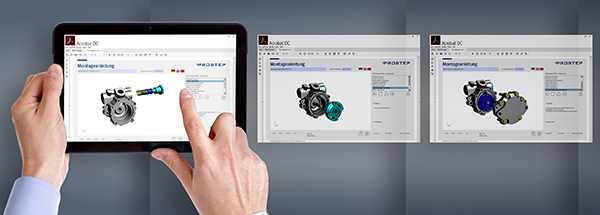
|

Planning and Documenting the Assembly Process in 3Dby Stefan Rulhoff Many systems could be delivered faster if their manufacturers were able to plan and document the assembly process more easily. PROSTEP's 3D PDF solution for assembly planning now allows them to start the planning process earlier and create the documentation faster and more easily. In addition, the clear-cut 3D documentation makes the technicians' work easier and helps avoid errors. Most machine and plant engineers still plan and document the assembly of their systems using the object in question, i.e. they assemble the system in its entirety or in parts prior to delivery so that they can properly document the process. New photos and illustrations are often created for the assembly instructions instead of using existing material from Engineering. This approach is not only time-consuming and labor intensive but also requires an unnecessarily large amount of space. The main problem, however, is that the technicians cannot start planning assembly and creating documentation until the system components have been manufactured, and by then time is usually short. As a result, changes made to the plant during operation are often not incorporated into the photo documentation that has already been created, leading to differences between the documentation and the actual system. Companies want to be able to start assembly planning earlier and calculate the assembly costs more reliably. They also want to reduce the time and effort needed to create the assembly documentation through the intelligent reuse of the 3D models from Engineering and improve the quality of the documentation so that the risk of errors during assembly can be minimized. And they want to be able to update the documentation faster and with less effort when changes are made to the equipment. All common CAD formats can be read In principle, 3D design allows the 3D models of the individual components to be assembled step-by-step using a computer and the sequence of the assembly operations to thus be specified. However, when it comes to large systems comprising thousands of components, performance problems can quickly arise, which is why the engineers usually only perform assembly at the level of individual assemblies or modules. In addition, companies would also need additional CAD workstations for assembly planning, which are relatively expensive to buy and maintain. One recommended alternative is therefore to use a lightweight format, which ideally can be animated to make the assembly operations easier to understand. 
PROSTEP's solution for 3D assembly planning is based on the company's own 3D PDF technology, which is able to convert 3D models from all common CAD systems into the tessellated PRC format making them more than 90 percent "lighter" than the original models. 3D PDF documents and the embedded models can be viewed using the normal Adobe Acrobat Reader DC, which is free of charge and installed on practically every computer. Another major advantage is that the 3D models can easily be combined within the document with 2D information such as detailed views, drawings and other textual information. The 3D PDF is very similar to conventional assembly documentation, aside from the fact that it can be made available both electronically and it can be printed on paper. The documentation can be compiled to a great extent automatically with the help of the server solution PDF Generator 3D and appropriate templates. 
Interactive animation of the assembly steps Companies can use the 3D PDF-based assembly planning solution to plan assembly operations digitally on the basis of the CAD models. A large library of typical assembly operations makes the planners' work easier and allows the assembly costs to be calculated reliably. Company-specific values such as cost rates, duration, etc. can be stored for the operations and enable assembly to be planned with an accurate timeframe and budget. The library can easily be expanded to include customer-specific assembly operations. A key strength of the PROSTEP solution is the ability to animate the 3D models of specific assemblies and components irrespective of the CAD system used to create them, i.e. after they have been imported into the 3D PDF document, thus making certain assembly steps easier to understand. The basis for this is provided by 3D PDF Pro for Adobe® Acrobat® Pro, which now allows more accurate navigation in the structure tree and more precise searches for specific component attributes. The search tool makes it easier to handle large assemblies in the 3D animations. 3D PDF Pro also makes the creation and adaptation of 3D PDF documents faster by automatically linking descriptive fields and buttons in the templates with the latest 3D contents. Optimal protection of intellectual property When viewing the embedded 3D geometry, Adobe Acrobat Reader DC, like any commercial 3D viewer, allows you to rotate and tilt the models, zoom in on them, and take certain measurements. The functional scope of Acrobat Reader can be limited when the 3D PDF documents are created in order, for example, to protect a company's intellectual property when the documentation is passed on to outside companies. It is even possible to use the optional PDF Generator 3D Rights Management module to restrict access to the documentation to certain people or impose a time limit, and also to revoke access rights previously granted. The 3D PDF solution from PROSTEP can very easily be integrated into an existing IT infrastructure in order, for example, to incorporate additional information from the PLM system or transfer information such as the assembly costs to the ERP system. This significantly reduces the amount of manual work required to create assembly documentation. Furthermore, the documentation can be updated pretty much at the touch of a button after changes have been made. Combined with the option of incorporating animated image sequences in the 3D PDF documents, 3D visualization makes it easier for the technicians to understand the assembly instructions and ensures that they made fewer errors. The digitalization of assembly planning allows this activity to be performed at an earlier phase, which helps shorten delivery times. |
|
| © PROSTEP AG | ALL RIGHTS RESERVED | IMPRESSUM | DATENSCHUTZERKLÄRUNG | HIER KÖNNEN SIE DEN NEWSLETTER ABBESTELLEN. |
